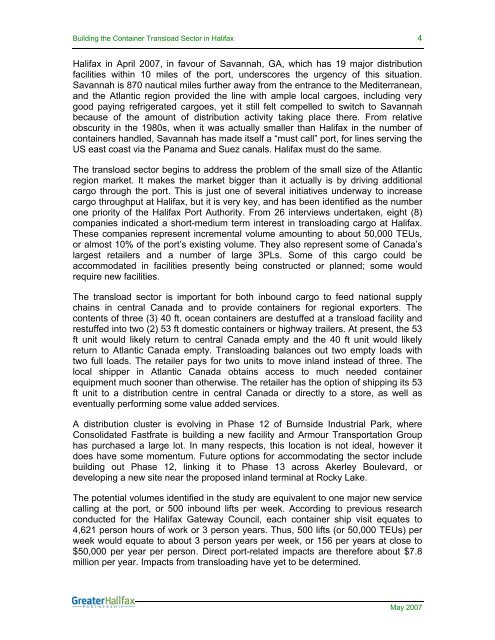Building the Container Transload Sector in Halifax - Halifax Gateway
Building the Container Transload Sector in Halifax - Halifax Gateway
Building the Container Transload Sector in Halifax - Halifax Gateway
Create successful ePaper yourself
Turn your PDF publications into a flip-book with our unique Google optimized e-Paper software.
<strong>Build<strong>in</strong>g</strong> <strong>the</strong> <strong>Conta<strong>in</strong>er</strong> <strong>Transload</strong> <strong>Sector</strong> <strong>in</strong> <strong>Halifax</strong> 4<strong>Halifax</strong> <strong>in</strong> April 2007, <strong>in</strong> favour of Savannah, GA, which has 19 major distributionfacilities with<strong>in</strong> 10 miles of <strong>the</strong> port, underscores <strong>the</strong> urgency of this situation.Savannah is 870 nautical miles fur<strong>the</strong>r away from <strong>the</strong> entrance to <strong>the</strong> Mediterranean,and <strong>the</strong> Atlantic region provided <strong>the</strong> l<strong>in</strong>e with ample local cargoes, <strong>in</strong>clud<strong>in</strong>g verygood pay<strong>in</strong>g refrigerated cargoes, yet it still felt compelled to switch to Savannahbecause of <strong>the</strong> amount of distribution activity tak<strong>in</strong>g place <strong>the</strong>re. From relativeobscurity <strong>in</strong> <strong>the</strong> 1980s, when it was actually smaller than <strong>Halifax</strong> <strong>in</strong> <strong>the</strong> number ofconta<strong>in</strong>ers handled, Savannah has made itself a “must call” port, for l<strong>in</strong>es serv<strong>in</strong>g <strong>the</strong>US east coast via <strong>the</strong> Panama and Suez canals. <strong>Halifax</strong> must do <strong>the</strong> same.The transload sector beg<strong>in</strong>s to address <strong>the</strong> problem of <strong>the</strong> small size of <strong>the</strong> Atlanticregion market. It makes <strong>the</strong> market bigger than it actually is by driv<strong>in</strong>g additionalcargo through <strong>the</strong> port. This is just one of several <strong>in</strong>itiatives underway to <strong>in</strong>creasecargo throughput at <strong>Halifax</strong>, but it is very key, and has been identified as <strong>the</strong> numberone priority of <strong>the</strong> <strong>Halifax</strong> Port Authority. From 26 <strong>in</strong>terviews undertaken, eight (8)companies <strong>in</strong>dicated a short-medium term <strong>in</strong>terest <strong>in</strong> transload<strong>in</strong>g cargo at <strong>Halifax</strong>.These companies represent <strong>in</strong>cremental volume amount<strong>in</strong>g to about 50,000 TEUs,or almost 10% of <strong>the</strong> port’s exist<strong>in</strong>g volume. They also represent some of Canada’slargest retailers and a number of large 3PLs. Some of this cargo could beaccommodated <strong>in</strong> facilities presently be<strong>in</strong>g constructed or planned; some wouldrequire new facilities.The transload sector is important for both <strong>in</strong>bound cargo to feed national supplycha<strong>in</strong>s <strong>in</strong> central Canada and to provide conta<strong>in</strong>ers for regional exporters. Thecontents of three (3) 40 ft. ocean conta<strong>in</strong>ers are destuffed at a transload facility andrestuffed <strong>in</strong>to two (2) 53 ft domestic conta<strong>in</strong>ers or highway trailers. At present, <strong>the</strong> 53ft unit would likely return to central Canada empty and <strong>the</strong> 40 ft unit would likelyreturn to Atlantic Canada empty. <strong>Transload</strong><strong>in</strong>g balances out two empty loads withtwo full loads. The retailer pays for two units to move <strong>in</strong>land <strong>in</strong>stead of three. Thelocal shipper <strong>in</strong> Atlantic Canada obta<strong>in</strong>s access to much needed conta<strong>in</strong>erequipment much sooner than o<strong>the</strong>rwise. The retailer has <strong>the</strong> option of shipp<strong>in</strong>g its 53ft unit to a distribution centre <strong>in</strong> central Canada or directly to a store, as well aseventually perform<strong>in</strong>g some value added services.A distribution cluster is evolv<strong>in</strong>g <strong>in</strong> Phase 12 of Burnside Industrial Park, whereConsolidated Fastfrate is build<strong>in</strong>g a new facility and Armour Transportation Grouphas purchased a large lot. In many respects, this location is not ideal, however itdoes have some momentum. Future options for accommodat<strong>in</strong>g <strong>the</strong> sector <strong>in</strong>cludebuild<strong>in</strong>g out Phase 12, l<strong>in</strong>k<strong>in</strong>g it to Phase 13 across Akerley Boulevard, ordevelop<strong>in</strong>g a new site near <strong>the</strong> proposed <strong>in</strong>land term<strong>in</strong>al at Rocky Lake.The potential volumes identified <strong>in</strong> <strong>the</strong> study are equivalent to one major new servicecall<strong>in</strong>g at <strong>the</strong> port, or 500 <strong>in</strong>bound lifts per week. Accord<strong>in</strong>g to previous researchconducted for <strong>the</strong> <strong>Halifax</strong> <strong>Gateway</strong> Council, each conta<strong>in</strong>er ship visit equates to4,621 person hours of work or 3 person years. Thus, 500 lifts (or 50,000 TEUs) perweek would equate to about 3 person years per week, or 156 per years at close to$50,000 per year per person. Direct port-related impacts are <strong>the</strong>refore about $7.8million per year. Impacts from transload<strong>in</strong>g have yet to be determ<strong>in</strong>ed.May 2007



